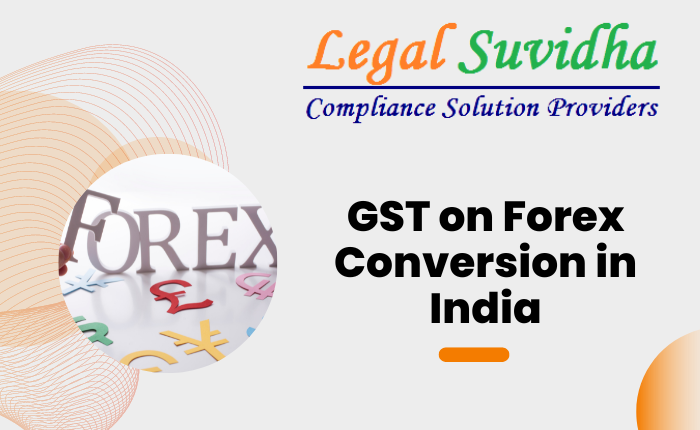Foreign Exchange conversion services are like currency transformers. They help people turn one type of money into another. It’s like when you have different coins, and you want to change them into bills or swap one country’s cash for another’s. In India, there’s something called the Goods and Services Tax (GST), and it applies to these currency exchange services.
So, let’s talk about how to figure out this GST stuff when you’re dealing with money conversions in India.
When you’re swapping your cash, the GST you have to pay depends on how much money you’re changing. There are two ways to figure it out:
Method 1: Calculation as per Rule 32(2)(a) of CGST Rule 2017
Case 1: When one of the exchanged currencies is Indian Currency (INR)
Sub-case 1: Availability of RBI Reference Rate
The RBI reference rate serves as the benchmark for establishing the currency value differential. When the RBI reference rate is available, the value of the foreign currency exchange is calculated as follows:
- For buying foreign currency: Value = (RBI Reference Rate – Buying Rate) * Total units of currency
- For selling foreign currency: Value = (Selling Rate – RBI Reference Rate) * Total units of currency
Sub-case 2: Unavailability of RBI Reference Rate
In instances where the RBI reference rate is unavailable for a specific currency conversion, the value of supply is determined as 1% of the Gross Amount (INR) received or supplied in the transaction. For instance, if Mr. Aman is selling or buying 100 USD at an exchange rate of 1 USD = 70 INR, the gross amount involved is INR 7000. Therefore, the value of supply becomes 1% of 7000, amounting to INR 70, with GST on this supply being Rs. 12.6.
Case 2: When both exchanged currencies are foreign currencies
In this scenario, the value of supply is calculated as 1% of the lesser of the final amounts resulting from the conversion of both currencies into INR. For example, if Mr. Aman intends to sell 100 USD for UK Pounds at a rate of 0.82 Pounds per USD, the value would be 82 Pounds. When both currencies are converted into INR, the taxable supply is determined as 1% of the lesser amount, which is 1% of 7000 INR, equivalent to Rs. 70. The GST applicable on this supply remains at Rs. 12.60.
Method 2: Slab-Based Calculation as per Rule 32(2)(b) of CGST Rule 2017
Alternatively, suppliers or service providers can opt for the GST computation method based on Foreign Exchange Conversion that follows predefined rules. It’s essential to note that if this method is chosen, a switch to another method is not permissible for at least one financial year.
| Serial Number | Gross Currency Exchange Amount | Value of Supply Formula | Value of Supply Calculation |
|---|---|---|---|
| 1 | Up to 1,00,000 Rupees | 1% of the gross currency exchange amount | Whichever is higher (A) or (B) |
| 2 | Exceeding 1,00,000 up to 10,00,000 Rupees | 0.50% of (total currency exchange amount minus 1,00,000 Rupees) | A + B |
| 3 | Exceeding 10,00,000 Rupees | 0.10% of (total currency exchange amount minus 10,00,000 Rupees) + Rs. 5,500 | Whichever is lower (A) or (B) |
For instance, if the gross amount is Rs. 10,000, the value of supply will be higher by 1% of 10,000 (i.e., Rs. 100) and Rs. 500, resulting in a value of supply of Rs. 500.
If You have any queries then connect with us at [email protected] or [email protected] & Contact us & stay updated with our latest blogs & articles


![Received an Income Tax Notice in India? Don’t Panic — Here’s Exactly What to Do [2025 Guide] 1 Income Tax Notice](https://legalsuvidha.com/wp-content/uploads/2025/12/Income-Tax-Notice.png)
![Cyber Crime FIR in India: How to File Complaint for Online Fraud, Banking Fraud & Digital Harassment [2025 Guide] 2 Cyber Crime Complaint](https://legalsuvidha.com/wp-content/uploads/2025/12/Cyber-Crime-Complaint.png)
![Trademark Infringement in India: How to File Legal Action & Protect Your Brand [2025 Guide] 3 Tradenark Infrigement](https://legalsuvidha.com/wp-content/uploads/2025/12/Tradenark-Infrigement.png)
![Property Title Verification in India: How to Check Clear Title in 7 Steps [Avoid Property Fraud – 2025 Guide] 4 Property Titles Verification](https://legalsuvidha.com/wp-content/uploads/2025/12/Property-Titles-Verification.png)



